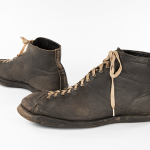Take a peek into our 14,000+ collection with our new blog series, From the Vault! Every other week, we’re sharing interesting stories about one of our artefacts.
What is the provenance of this pair? When did they enter the BSM collection?
This pair entered the collection in 1980. They were acquired in an antique shop in Victoria, B.C.
Are there any features that distinguish this pair from other footwear from the same period and geographical location?
This style of clog is most typically called a Lancashire clog and was a form of working-class footwear worn throughout Great Britain but most commonly in the industrial towns in the north from the 19th century well into the middle of the 20th. They were durable and inexpensive with metal reinforcements added to the wooden soles to increase longevity. This style of footwear was commonly worn by workers in the northern textile factories and led to the creation of Lancashire clog dancing as women working in the factories repeated the beat of the machines they were working with. These steps were then incorporated into dances.
Can you elaborate more on the materials used to make this pair?
Lancashire clogs typically have wooden soles that feature metal reinforcements at the heel and along the sole to the toe. They also typically feature thick leather uppers closed with buckles, instep straps, or lacing.
Who would have worn this pair and where or for what occasion?
Many of these clogs were brought to Canada via Irish, Scottish, and British immigrants. The style was also brought to the US and 19th century shoemakers in both countries also made this form of footwear locally. The preponderance of children’s examples in North America, including this one, suggest that some were made, or sold, as mementos of ‘home’ but some many also show evidence of wear.


